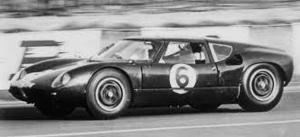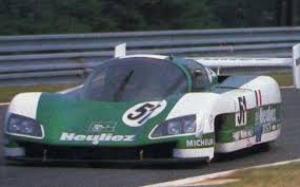Benz Tropfenwagen, 1923
Based on the teardrop shaped
Rumpler four seat road car, this was the first mid-engined
grand prix car. It was designed with a low frontal
area and a teardrop shaped fuselage to reduce drag.
The purpose of a teardrop shape is to keep the air flow
boundary layer attached which reduces negative pressure
wake and therefore form drag.
Auto Union, 1934-38
In 1934, Dr. Ferdinand Porsche
further refined the teardrop shape in this mid-engined
grand prix car. Later, the cockpit was fully
enclosed to pursue speed records. A 545 hp blown V16
powered the fastest version to 267 mph which then
crashed. The record breaking coupe was susceptible
to cross winds and had lift at speed.
Michael May's Porsche Type 550 Spyder, 1956
Far ahead of his time, Michael
May was the first to use a wing to increase overall grip
of the car. He mounted a cockpit-adjustable wing in
the middle of this mid-engined, 1500 cc, 125 hp
Porsche. In practice, this novice driver in his
winged car challenged the most powerful cars of its day,
but it was not allowed to compete.
Ferrari 250P, 1963
In 1961, a V6 mid-engined
Ferrari spyder was the first to use a spoiler on the rear
deck. The spoiler "welled up" the airflow on the
deck creating a high pressure area and thus reducing lift
at the rear. The spoiler was widely used in the
1960's and a prime example was the Le Mans-winning Ferrari
250P. Tire advances allowed 1 G cornering in the
early 60's.
Ford-Lola Mk 6 GT, 1963
Reviving teardrop streamlining, this fully  enclosed coupe
incorporated a downward sloping "fastback" rear
deck. Unfortunately, the original had no rear
spoiler (but was added later). Typical of cars in
its day, its curved under nose was believed to help the
car "cut through" the air as a boat hull "cuts through"
the water.
enclosed coupe
incorporated a downward sloping "fastback" rear
deck. Unfortunately, the original had no rear
spoiler (but was added later). Typical of cars in
its day, its curved under nose was believed to help the
car "cut through" the air as a boat hull "cuts through"
the water.
Ford GT40 Mk I, 1964-66
The Ford GT40 was first car to
"trim out" both front and rear lift through the use of
spoilers. Like its predecessor the Lola GT, the GT40
was a low frontal area fastback design (although its
fastback notched slightly between the rear window and
deck). While its "untrimmed" shape had front and
rear lift, a front spoiler (directing air to the radiator)
reduced the "ramming" and "wedging" of air under the nose
and the rear spoiler kept the flow attached to the notched
rear deck.
 400 kph (249 mph) with a low drag, stable
GTP class car. With its low down force underwing
(1100 lb), enclosed rear tires and partially enclosed
front tires, the 900 hp car officially clocked 251 mph
(405 kph) in 1988 Le Mans qualifying.
400 kph (249 mph) with a low drag, stable
GTP class car. With its low down force underwing
(1100 lb), enclosed rear tires and partially enclosed
front tires, the 900 hp car officially clocked 251 mph
(405 kph) in 1988 Le Mans qualifying.  For decades cars at Le Mans have
sacrificed grip to optimize for low drag (Porsche 917 long
tail). The Mercedes-Benz CLR was a GT1 class flat
bottomed car which the designers attempted to eliminate
down force for speed and fuel economy. However,
there was no margin of safety with the CLR because two
cars "blew over" in Le Mans practice and one became air
born in the race. In these incidents the CLR was
following another car at a location where there was a
"falling away" of the track. It is quite likely that
turbulence from the leading car and the "angle of attack"
change adversely affected the lift of sharp nose (a shape
inherently prone to instability).
For decades cars at Le Mans have
sacrificed grip to optimize for low drag (Porsche 917 long
tail). The Mercedes-Benz CLR was a GT1 class flat
bottomed car which the designers attempted to eliminate
down force for speed and fuel economy. However,
there was no margin of safety with the CLR because two
cars "blew over" in Le Mans practice and one became air
born in the race. In these incidents the CLR was
following another car at a location where there was a
"falling away" of the track. It is quite likely that
turbulence from the leading car and the "angle of attack"
change adversely affected the lift of sharp nose (a shape
inherently prone to instability).